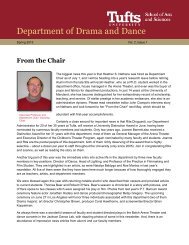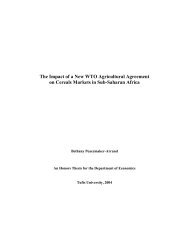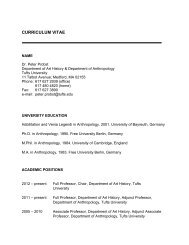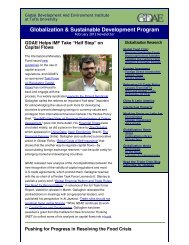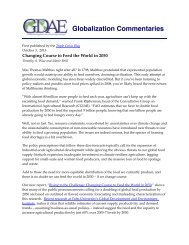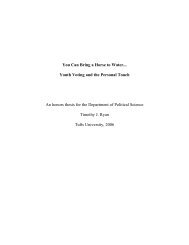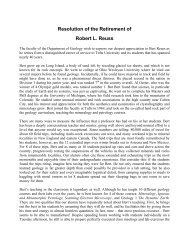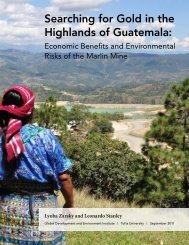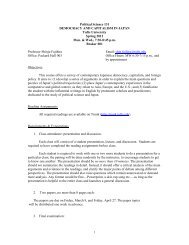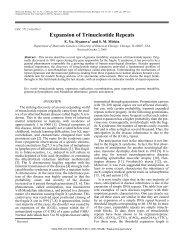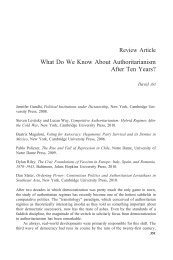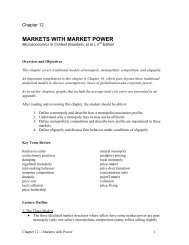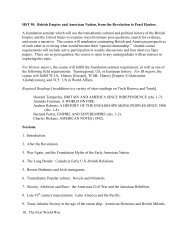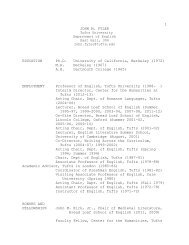Is A Main Street Program Appropriate for Mattapan? - Tufts University
Is A Main Street Program Appropriate for Mattapan? - Tufts University
Is A Main Street Program Appropriate for Mattapan? - Tufts University
You also want an ePaper? Increase the reach of your titles
YUMPU automatically turns print PDFs into web optimized ePapers that Google loves.
commercial districts that lined Blue Hill Avenue, including Morton <strong>Street</strong>,<br />
slowly died when the businesses that comprised them continued to fail . In<br />
contrast, <strong>Mattapan</strong> Square thrived as its counterparts, including Morton<br />
<strong>Street</strong>, along the Blue Hill Avenue corridor slowly faded (Rappaport Institute)<br />
.<br />
Through the years, Boston has undertaken many initiatives meant to stave<br />
off the decline of its commercial districts . However, the city did not specifically<br />
target the entire <strong>Mattapan</strong> area in those initiatives . In 1977, it set to<br />
reconstruct the portion of Blue Hill Avenue between Morton <strong>Street</strong> and the<br />
Grove Hall area . The following year, the city applied to the federal government<br />
<strong>for</strong> over $7 .5 million in grant funds to rehabilitate Blue Hill Avenue,<br />
which would have benefitted its portions running through <strong>Mattapan</strong> . During<br />
the 1980’s, through the Boston Urban Gardeners’ program, the city planted<br />
trees on the Avenue and created urban gardens planted by Boston youths .<br />
In the 1990’s, the Menino Administration launched the RESTORE program<br />
to launch community economic development . That program, from 1994 to<br />
1999, was credited <strong>for</strong> many positive changes in area businesses:<br />
RESTORE renovated or expanded 30 businesses, helped estab<br />
lish 12 new businesses, retained 180 jobs, created 40 jobs, and<br />
invested $2 million in public-private partnerships on Blue Hill Av<br />
enue. In all, public-private investment along Blue Hill Avenue to<br />
taled more than $51 million between 1994 and 1999 (Rappaport<br />
Institute).<br />
While the city launched programs such as RESTORE, which indirectly<br />
helped areas of <strong>Mattapan</strong>, it also introduced Boston <strong>Main</strong> <strong>Street</strong>s to revitalize<br />
the commercial districts within its neighborhoods .<br />
As various areas of Boston received “<strong>Main</strong> <strong>Street</strong>s” designation, a group<br />
of <strong>Mattapan</strong> stakeholders decided that <strong>Mattapan</strong> needed special attention<br />
in terms of business development and applied to bring the program to<br />
the neighborhood . During those early years, Lilly Searcy, now director of<br />
Action <strong>for</strong> Boston Community Development’s Family Service Center in <strong>Mattapan</strong>,<br />
spearheaded the process that would have brought the organization<br />
to the Square .<br />
Searcy said that some 100 people contributed to putting together the application<br />
. A professional grant writer wrote all of the materials requested by<br />
the city . Businesses pledged nearly $10,000 to support the ef<strong>for</strong>t . Others<br />
within this application committee agreed to donate their time . “One organization<br />
did not support it, and that stopped the process . The city did not<br />
want any controversy,” she said . (As we will see later, the <strong>Mattapan</strong> Board<br />
of Trade is resistant to the idea of bringing <strong>Main</strong> <strong>Street</strong>s to <strong>Mattapan</strong> .)<br />
12<br />
“For the application to move <strong>for</strong>ward, there has to<br />
be support from the business community. I hope<br />
that they are not repeating the cycle.”<br />
Some years later in 2001, Searcy attempted, again, to bring a <strong>Main</strong> <strong>Street</strong><br />
program to <strong>Mattapan</strong> Square . According to her, that application did not<br />
succeed because of a lack of community consensus . The <strong>Main</strong> <strong>Street</strong><br />
application packet clearly requires widespread support <strong>for</strong> a community to<br />
host a program:<br />
Broad based neighborhood support <strong>for</strong> the commercial dis<br />
trict’s revitalization and <strong>for</strong> long term participation in Boston <strong>Main</strong><br />
<strong>Street</strong>s. Merchant organizations, neighborhood organizations,<br />
schools, religious institutions, property owners, residents, civic<br />
groups and lending institutions should be willing to work together<br />
as a team <strong>for</strong> the successful revitalization of the commercial district<br />
(Boston <strong>Main</strong> <strong>Street</strong>s application).<br />
Searcy also admits that the second process did not have the same range of<br />
community stakeholders supporting it . “It needed more community participation<br />
.”<br />
She knows that the <strong>Mattapan</strong> Community Development Corporation<br />
(MCDC) and other stakeholders aim to submit another application to the<br />
city when it announces the newest request <strong>for</strong> proposals . “For the application<br />
to move <strong>for</strong>ward, there has to be support from the business community<br />
. I hope that they are not repeating the cycle .” Today, if the city makes<br />
another call <strong>for</strong> proposals <strong>for</strong> another <strong>Main</strong> <strong>Street</strong> program, the problems<br />
which foiled past attempts, still exist today .<br />
CoMMeRCIal noDes anD PRoPoseD PRoJeCTs<br />
Part of <strong>Mattapan</strong>’s current business climate is that the region has essentially<br />
four commercial nodes . There are some areas of commercial activity on<br />
River <strong>Street</strong> that are not under consideration by the parties now interested<br />
in applying <strong>for</strong> <strong>Main</strong> <strong>Street</strong> designation . The clusters that are under consideration<br />
are best defined in the city of Boston’s <strong>Mattapan</strong> Economic Development<br />
Initiative (MEDI) report . One area is on Morton <strong>Street</strong>, specifically<br />
its most active areas of commerce from Selden <strong>Street</strong> to Norfolk Avenue .<br />
There is also another cluster of businesses on Morton <strong>Street</strong> that caters to<br />
the Haitian community .<br />
The other area under serious consideration <strong>for</strong> the <strong>Main</strong> <strong>Street</strong> program is<br />
the series of stores from <strong>Mattapan</strong> Square to Morton <strong>Street</strong> on Blue Hill Avenue<br />
. There are many individuals and entities that would prefer to see the<br />
program launch in the square, which is zoned by the BRA as a community




